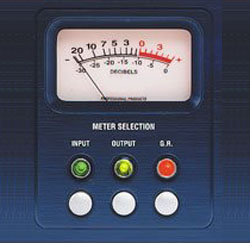
Common Compressor Mistakes
Extreme settings will lead to extreme results. If you set an infinite ratio and turn the threshold down to -40 dB, the compressor will do what it’s being told to do: turn the level way down.
Trying to compensate by cranking the output control to its maximum amplifies the noise of the mixer, EQ, microphone preamp, and the compressor itself. This noise will fade in whenever the input signal stops, resulting in the classic “pumping” and “breathing” problems.
In short, noise is present in every system, and improper use of any compressor will amplify it to an obnoxious level.
If the ratio is set to 1:1, it doesn’t matter where the threshold control is set: the compressor is being told not to change the gain at all, even if it’s above the threshold level. None of the reduction LEDs will light, and the compressor may as well be in bypass mode.
Similarly, if the ratio is infinite and the threshold is high, or the input trim of the mixer or microphone preamp is too low, there will be no compression. Further, if the output level control is raised, the noise floor will be amplified.
For low noise operation, make sure your mixer, compressor, and amplifier settings are set properly. As a general rule, you want as much gain as possible in the front of the system (at the microphone preamp), so that a good line level signal is traveling through the whole signal path.
If you have a weak signal to start with, and then amplify it at the end of the signal path (by turning the main outputs of the mixer all the way up, for example) it will be excessively noisy.
When using a compressor with a live sound system, improper settings can cause feedback. Make sure that a channel is well below the feedback point when there is no gain reduction active. If you hear feedback every time the music stops, you must lower the overall level of the system.
Pumping and Breathing
When a compressor is making large changes to the input signal (10 to 12 dB or more); the noise floor will also rise and fall with the signal level.
When this noise signal rises and falls drastically between signals, such as a heavily compressed, noisy drum track, you might hear the noise level “breathing” between drum hits.
One solution to this breathing problem is to turn up the release time. This way, the noise floor won’t have time to rise between drum hits.
However, if the release time is too long, lower level signals after the peak will be lost as the compressor slowly stops reducing gain.
This is called “pumping” as the lower level signals (noise included) slowly fade back up to their normal signal level.
The secret to avoiding these problems is to achieve a balanced release time on the input signal.
This article is courtesy of dbx professional.
